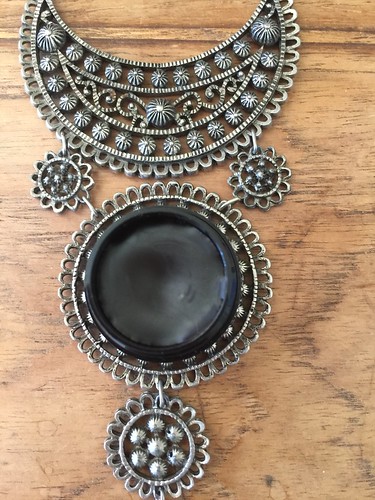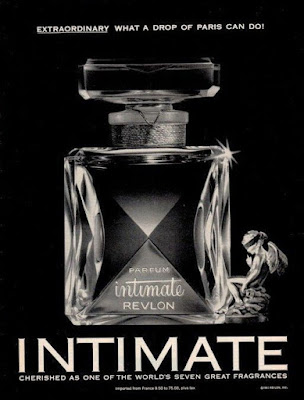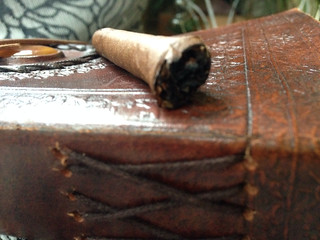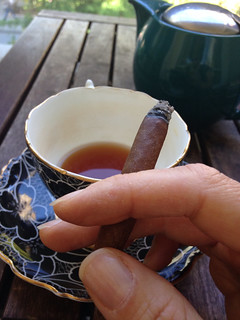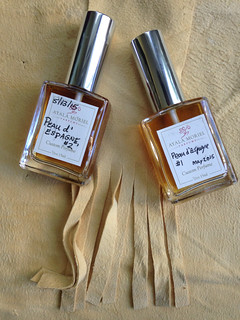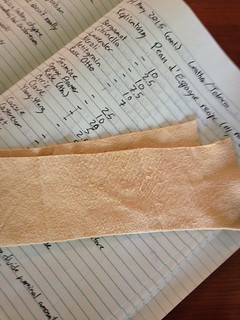Decoding Obscure Notes: Civet

“Civet: Animal secretion from the so-called civet “cat” – an African animal that resembles a mongoose in appearance. The male and the female have special glands located between their genitalia and anus that produce civet. The civet was first discovered in coffee plantations, from which they would steal coffee berries. Curiously, civet coffee (beans recovered from civet faeces) is now sought after by coffee connoisseurs, and sold for a prime price. Less exciting to learn is the fact that most, if not all, civets are kept in captivity under horrible conditions. The reason is that the more angry and agitated these animals are, the more civet they produce. They are held in small cages and occasionally poked and prodded with sticks to “encourage” the secretion of civet. Therefore, civet has become a controversial raw material, as there are no known ethical or cruelty-free civet farms. Civet secretion is processed with solvent to produced an absolute – a thick paste with an enormously intense odour, dominated by indole and paired with other animal nuances that are warm, strong and musky. At low dilution, they create a very pleasing, almost floral sweetness that is sadly inimitable.”
- Excerpt From: Ayala Moriel. “Foundation of Natural Perfumery: A Practical Hands-on Guide for Creating Your Own Fragrances.”
While preparing my article about The Painted House and Z'bad, I realized to my astonishment that after all these years of blogging, I have never dedicated an article to civet! Civet is perhaps the most iconic animalic raw material, without which many classics would simply not exist. Too many to count, really, but just from the top of my head - Tabu, Youth Dew, Joy, Miss Dior, Diorissimo, No. 5, Jicky, Bal a Versailles, Korous, Old Spice and so many more. While many perfume nerds know about indole as being the major component in the faecal hit that civet is known for, very few have actually ever smelled it in its raw form. Civet has a paste-like, golden appearance and texture not unlike a generous dollop of human earwax treasure. In its raw form, civet is overbearing and intrusive. Impolite to say the least. But there is more to it than indole.
Zoology and of Civet:
Researching this animal, I realize how little I know about the animal kingdom. And while researching and trying to understand the zoological classification of civets, I also found out not only that hyenas are more related to cats than to dogs, but also some fascinating facts about the spotted hyena's female genitalia, which is a proof that nature is a lot less decisive about male-female distinction. But I digress so let's turn back to civets.
First of all, although they share some physical similarities, mongoose are closer to cats than they are to civets, so my analogy is not all that off the mark. Both the mongoose and the cat belong to the Feliformia suborder. Civet (Civettictis civetta), however, belongs to the suborder Viverroidea and the family Viverridae, which are the primitive predecessors of the feliformia. It consists mostly of the genera: Viverra, Genetta, Herpestes, and Suricata. The "civets" in this family belong to three sub-genres within the viverranae sub-family: Genetta, Poiana, Viverra (which has many types of "civets" within it), viverricula (which consists only of the Indian civet), and lastly the Civettictis where our subject, the African Civet (which originate in Ethiopia) belongs and is the only member of, and also the main one of interest to perfumery (and to a lesser extent also the Indian civet).
These animals are mostly found in Africa and Southeast Asia. They like various habitats, including mountains, savanna, woodlands and especially thick tropical forests. Unfortunately, with the massive deforestation on our planet, their habitat is diminishing. Most of the animals belonging to this family have renewable scent glands on their skin. They have long tails and long snouts, particular teeth structure which I won't bore you with and other anatomical characteristics. Basically these are small carnivores (smallest being the wee African linsang, and the largest of them being binturong, which can go up to 25kg). The civet in question, however, is actually an omnivore, relying mostly on a plant-based diet consisting of fruit and somewhat on nectar. Which explains why it likes to eat coffee berries and produces the famous "kopi luwak" from the partly digested coffee "beans". But more on this later.
The African Civet's scent glands or "pouches" are located near the anus, and occur in both males and females. However, the males produce larger quantities of the funky civet secretion. It is unclear what is the purpose of these glands, but it is very likely a deterring mechanism, much like the skunk: the animals produce more of this secretion when they are under stress.
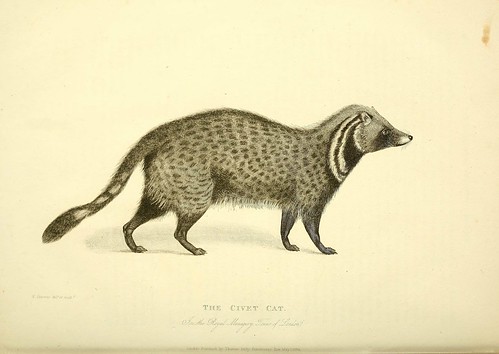
Historical Uses:
The African Civet is native to Ethiopia, and therefore we need to look into this country's history and heritage to discover the first relationships mankind had with this animal. It is believed that civet paste was used in Ethiopian perfumes, cosmetics and perhaps also incense from time immemorial, and that Queen of Sheba brought this as a gift to king Solomon. Yemen being just across the Red Sea from Ethiopia would explain the emergence of the Zbad (زبد) perfume paste in this country - a solid perfume or unguent made mostly with civet, and with added resins, spices and perhaps even with other animal musks. The specimen I have is redolent of camphor, spearmint, myrrh and opoponax.
Even to this day, Ethiopian civet is collected in cups made of zebu horn (a type of an ox), which is also where they were traditionally stored. Each horn would be filled to the brim with the semi-solid civet paste, the production of four years of civet from one animal - between 35-40oz of the material. It was often also adulterated with other zebu products, such as clarified butter, other fats, beeswax, honey and even baby excrements (!). To test the civet for quality, civet traders would actually taste this paste, with the honey being a tell-all sign for adulteration. Yum.
Zeved (זֵבֶד) is mentioned in the the Torah (Old Testament) once, although in a different connotation - a blessing of thankfulness of Leah after giving birth to her son Zevulun. In this context, the word could mean a gift, but it might also have meant perfume, and some modern translation use the same word (which has very similar spelling equivalence to the Arabic Zbad) - it is used simply as "civet".
It is speculated that the third gift the magi brought to Christ upon his birth along with the frankincense and myrrh was not gold (Zahav in Hebrew), but in fact civet. Since the New Testament is originally in Greek I can't comment on the language there, because my knowledge of this language is less than minimal.
Preparation of Civet Extracts:
Crude civet paste is extracted with hydrocarbon (a solvent) to produce a concrete, which is further processed with alcohol to yield an absolute.
A low-tech Civet extract in the form of tincture can be fairly easily prepared from the crude civet excretion by alcohol maceration, using one of the following ratios of civet paste to 95% ethanol:
1:5 (labeled as 20% civet tincture)
or -
1:10 (labeled as 10% civet tincture)
This mixture can be placed to macerate overtime, or gently heated, then chilled prior to filtration, in order to separate any fatty or waxy material from the alcohol.
What does Civet Smell Like:
Civet has a distinct animal, faecal odour which is full concentration is objectionable and repulsive, smelling like fear and danger. Just like the animal's state of mind when it secrets it. Upon dilution to 10% it is still very strong and repulsive, like pubic hair and the nether region after not being washed for more than a day. At 1% would, civet presents a honeyed, floral aroma, sweetly reminiscent of unwashed beard, sexy and with a still superb diffusive powers.
Chemical Makeup
Civet extracts (tincture or absolute) is especially known for being dominated by indole and skatole (AKA civettol, which is closely related to the former) but the truth is that these only appear in small amounts (about 1%). The more important molecules in civet is the musk cyclohexadecanone (AKA civettone or zibethone)[1], which gives civet its honeyed, musky-floral, lasting power. Civet that has too much faecal or uric qualities is likely adulterated with indole and skatole, and in any case is considered of inferior quality.
Both civettone and civettol were successfully synthesized, and have largely replaced civet in the fragrance industry, their appeal not limited to their consistency and availability, but also to their lack of faecal facets. In this exactly lays their disadvantage though - because they do not represent the full spectrum of natural civet.

Civet in Perfume:
There is hardly any class of perfumery that can't use some civet, even if just for its fixative qualities. And indeed, one of its most versatile uses is to prefix alcohol. Civet is particularly valuable in floral compositions, giving them not only lasting power, but also a highly diffusive power, depth of character and enhanced aphrodisiac qualities. It is especially valuable in narcissus basis, but is also very useful (in minute quantities, of course) in lighter florals such as Lily of the Valley (Diorissimo being a prime example). However, civet in large and identifiable quantities is particularly in use in the oriental classification, rounding off to Spicy/Woody Orientals, adding depth and warmth to Ambery Orientals and amber bases, honey bases, "black" musk compounds (as opposed to the "white musk" which is relying on ambrettolide and other vegetal musks), leather, Fougère, and more. Civet goes particularly well with rose, jasmine, agarwood, ylang ylang, orange blossom, honey absolute, vanilla, patchouli, tonka bean, other musks, and more.
Civet in Flavour:
Perhaps you'd be surprised that civet finds any use in flavour, especially after reading about its adulterants. But it is in use, especially in compounding berry flavours, and finds its use to many flavour categories, including alcoholic beverages, soft drinks, chewing gum, baked goods, frozen dairy, puddings/gelatin products, hard and soft candy (Fenaroli's Handbook of Flavor Ingredients, p. 333). No specifics were provided.
The coffee aficionados have probably heard of the lucrative Kopi Luwak - coffee beans that were partly digested by civets, and therefore have not only gotten an additional extra special aroma, but also the process of passing through the creature's digestive tract have fermented them and created a supposedly superior taste. These can go for a very high price - I have seen a small tin of roughly quarter of a pound sold for $100 many years ago, and recently for a much reduced price of $45. Some places are reputed to serve a single cup for a $100, so this sounds like a very good deal. However, as curious as I was - I did not feel comfortable supporting this kind of product, not to mention actually ingesting it. So I can't comment from first hand about its hedonic value.
Civet and Ethics:
It's impossible to talk about civet without discussing ethics (or lack thereof) and animal welfare. African Civets are the ones commercially used and are captured from the wild and kept in small cages to keep them in a state of fright. The reason being, that the more pissed off they are, the more secretion they'd produce. As mentioned earlier, African Civets eat mostly a vegetarian diet. However, when fed meat, it was discovered that they produce way more secretion.
Here's an excerpt from Arctander's "Perfume and Flavor Materials of Natural Origin" to give you an idea of civet's living conditions, including its diet over four years - the amount of time a civet takes one civet to fill a zebu horn with a marketable amount of secretion:
"During this period, the animal will consume something like the raw meat from 50 (fifty) sheep, and the poor cat, frequently teased in its narrow cage, will have undergone 400 to 800 painful "scrapings" of its glands. The raw meat diet, the narrow cage and the teasing are all means of increasing the production of the civet secretion which is scraped off with regular intervals while the cast is caged." (p. 174). The ethical questionability in it is not just with the animal torture itself (and changing its diet to something it won't normally eat), but also the many sheep that get killed in the process, in very poor countries where they typically are used to feed entire families for years on end as dairy, and only occasionally slaughtered.
Civet boycotting began in the 1970s, but have drastically increased in the last couple of decades, thanks to the internet and more recently the advent of social media, animal welfare and activism have taken the forefront on civet issues, and large (and small) perfume houses felt a pressure to be politically correct and deny their use of civet in their perfume. This is only a half truth. While I'm certain most mass-produced perfumes no longer contain civet, not only because of their cost, but also because of the general decline in strong, dark musky animal notes in the general market; I'm just as certain that many perfume houses still use civet, which is necessary in many older formulations which are still commercially viable (classics such as No. 5, for instance, are still using high quality natural raw materials exclusively for the extract formulation, and I won't be at all surprised that natural civet is still in that jus). Just because companies announce they don't use something doesn't mean that they stopped using it. The proof is in the pudding. If this were true, there would be no more civet farms, would they not?
The fact and the matter is, civet is still raised commercially in Africa for scent-gland scraping which is mostly for use in perfume and finds some use in flavour also. Other farms (primarily in Asia) specialize in raising civets close to coffee plantations and feed them exclusively on coffee berries until they have blood-shot eyes from caffeine overdose. Both types of civet farming are alive and well as anyone who visits them could attest to. It's not just the Kopi Luwak aficionados that are responsible for the existence of civet farming - and subsequent cruelty.
Boycotting is a huge tool to raise awareness to an issue. But it is rarely a solution to a problem. On the contrary - it makes a bunch of privileged people (I'm talking about all of us in the perfume industry) feel better about ourselves, and rienforcers our sense of entitlement by flaunting righteousness all while doing absolutely nothing to solve the problem beyond sitting at the comfort of our armchair and pretend like we're solving the world's problems.
Just as the war on drugs has not erased drug use and its many dark implications on society (like crime, prostitution, overdose, contractions of STDs, etc.) or improved the life of those affected by drug abuse - so did the boycotting on civet hasn't improved one bit the conditions in which civets are raised not supports the civet farmers to abandon those practices and replace them with humane ones. While the West is boycotting civet loudly, civet farmers are getting paid less and less for their labour, and instead of selling directly to the fragrance houses before those washed their hands from the whole civet trade - they need to pass it through several hands to the larger grey markets in Asia, and finally it ends up with the same fragrance houses in France and the USA.

Solution to the Problem?
The correct way to remedy this as an industry is to claim responsibility and directly purchase from civet farmers, while at the same time improving the civets conditions, and supporting those farmers in transitioning to
Throughout the years of my work, I haven't used civet for commercial purposes, because I did not feel comfortable with this situation. Now that I have better understanding of the issues surrounding civets, and also live closer to where they are grown - I feel that I would like to be more involved in making civet conditions humane, and as a result also having an ethical civet product on the market. This is a huge undertaking - way bigger than one perfumer can do on her own, but if many of us small indie perfumers will show support for this trade and get truly involved, if we continue this discussion and start following an action plan, I think we may be able to use civet ethically in our lifetime.
I highly encourage you to read all of Dan Riegler's articles on the topic. Dan visits in Ethiopia frequently and has contact with civet farmers and even an action plan for how to make this happen. Let's support him and make civet trading ethical! This will benefit everybody - the civets, the farmers who raise them, the classic perfumes that had civet in their formulation, and also new natural perfumes that could be created using them, guilt free.
[1] Please note Wikipedia entry for civet in perfumery lists three other molecules, cyclopentadecanone, cyclohexadecanone, cycloheptadecanone, and 6-cis-cycloheptadecenone, which upon further research are either compounds of the muskrat odour, or simply misspelled.


